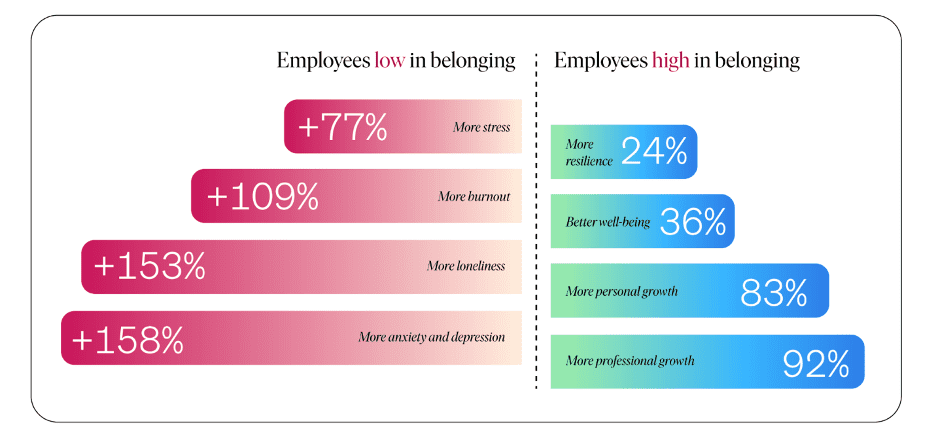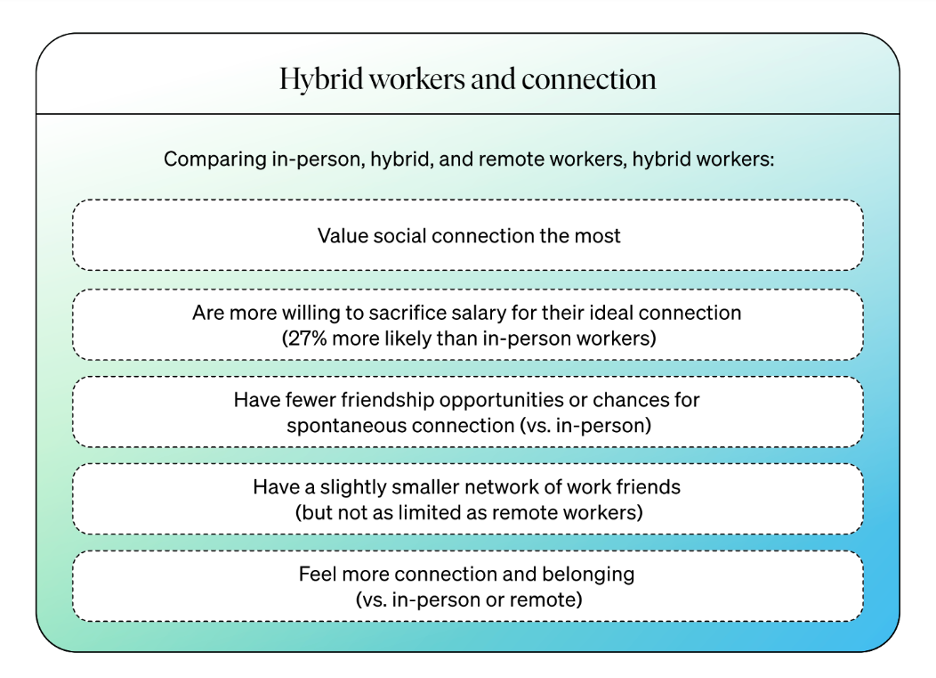Since the dawn of man, connection, community, and communication have been essential for our survival and development as a species. Many things have changed over the last thousands of years, but the importance of connection has remained the same.
BetterUp’s report on Why community matters in the new world of work found that if you want your company to evolve, you need to make connection, community, and communication a priority for your team.
The employee experience is built on the foundation of these three principles. In addition, BetterUp’s research discovered critical information on the correlation between success and connection. Below we will discuss the highlights of their report and look at real-life ways you can make a difference in your employee experience.
The truth is in the data
We can blame it on the pandemic, but the truth is that connection in the workplace was in trouble well before COVID. Former Surgeon General Vivek H. Murthy said that more than 40% of Americans felt lonely. He attributed this loneliness to a lack of workplace connection. And medical research has found that loneliness runs the same health risk as smoking 15 cigarettes a day!
We spend the majority of our time at work. Therefore, it is vital that we feel a sense of community and connection with our workmates. Unfortunately, glassdoor found that only 31% of folks felt connected to the people they work with.
BetterUp found that 96% of leaders understand the importance of community, but most employees still need help to forge connections at work. Most believe their organization is responsible for cultivating a workplace culture that prioritizes relationship-building and camaraderie.
It surveyed employees of 78 independent organizations and found that:
- 4.3/10 don’t feel connected at work
- 4.4/10 don’t have a true friend at work
- 5.3/10 don’t look forward to work because of their co-workers
- 6.1/10 don’t socialize with co-workers outside of work
Prolonged bouts of weakened social ties are detrimental to employees’ physical and mental health. Those with a low feeling of belonging to their organization experience 158% more anxiety and depression, while those with a higher sense of belonging have a 36% increase in overall well-being and 92% more professional growth.

Employee retention is also a significant factor when it comes to workplace connection. BetterUp found that employees who felt disconnected from their co-workers had a 39% higher turnover rate, a 313% stronger intention to quit, and a 176% higher likelihood of job searching outside their organization.
On the brighter side, teams who are within more socially connected workplaces are
- 52% more able to generate new and valuable solutions when faced with challenges
- 38% more likely to take calculated risks
- 17% less likely to experience conflict
The data shows that a workforce crisis is coming if steps are not taken to improve communication, community, and connection. So let’s explore a few ways to avert this crisis.
Connections are crucial
Connection should start with onboarding and continually build throughout an employee’s time with your organization. The objective is not only for them to feel a link to their work goals, but it should also allow them to build meaningful relationships with others outside their core team. Assigning a work buddy or mentor is a great way to jumpstart workplace connections. You can even take it a step further by rotating buddies/mentors bi-weekly or monthly for the first few months.
Connection starts from the top and can be as simple as sharing your organization’s mission. Employees say that when managers share their goals with a clear action plan for the team, it helps them understand how their work fits into the bigger picture. This, in turn, makes them feel more invested in the outcome.
But what about employees who work remotely? It’s easy to blame the lack of connection on a dispersed workforce, but bringing everyone back to the office will not solve the problem. It’s true that those who work remotely feel more disconnected despite the advancements in technology designed to connect them. But in-office workers feel a similar decline in connection.
Surprisingly, hybrid workers scored the highest on feeling a sense of belonging in the workplace. They also valued social connection the most. So absence does make the heart grow fonder, and hybrid work could be the key to cultivating employee relationships in the workplace!

Community creates connections
Community enhances the employee experience and brings meaning beyond the daily task and paycheck. Over half of employees say they would choose a workplace with a strong community and connection over higher pay. It’s that important!
A culture of connection is an advantage when scouting the top talent, and your current employees may look elsewhere if you don’t have it. So it’s all about creating a cohesive work culture where employees feel respected, valued, and included—a place where they can simply flourishTM.
With just a little planning, getting out of the office to socialize fosters friendship and camaraderie that flows back into the workplace. Of course, virtual get-togethers work just as well—think trivia night, bake-offs, or virtual happy hours. Another great way to build community is by volunteering at a local charity. Ideally, it would be best if you considered these relationship-building events as a buffet. Offer various opportunities with different events, times, and locations so that there is something for everyone.
Communication for successful outcomes
Organizations can only be successful with stellar communications. It is the foundation for everything; without it, all efforts for connection and community will fail. Communication boosts employee morale and productivity. It’s the key to effective team collaboration in the workplace and a better employee experience.
Using the right method of communication is just as important as communication itself. We’ve all had the experience of sitting through a meeting with the thought, “this should have been an email.” Allowing employees to personalize how they send and receive communications gives them ownership and enables them to communicate more effectively.
Communicating your organization’s core values, informing employees about important internal affairs, or giving a shoutout to a team member’s achievement sets the stage for all aspects of business, especially regarding the employee experience.
Reach out for a demo and see how Simpplr can support your organization’s goals of building a solid work community that enhances your employee experience and cultivates connections!


















